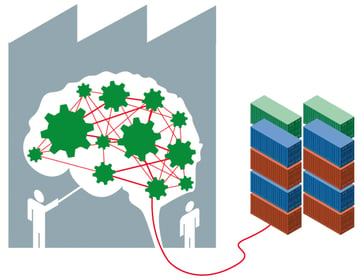Optimize Your Inventory Management with These 3 Strategies
Brian Hoey - September 20, 2018

 Imagine you’re packing up supplies for a backpacking trip across Tuscany. You’re limited by how much you can comfortably carry for many miles of walking, and you have to decide which items and in what quantities you’ll need in order to make it the entire length of the trail. You start with clothing and a first aid kit—but how much food do you bring? You want to pack light, and you think that you’ll reach the next town (where more food could potentially be acquired) within a day or two, but if you’re forced to slow down for some reason you don’t want to run out of things to eat. Bringing more food, however, means leaving behind one or two of the books you planned to read in your more leisurely moments.
Imagine you’re packing up supplies for a backpacking trip across Tuscany. You’re limited by how much you can comfortably carry for many miles of walking, and you have to decide which items and in what quantities you’ll need in order to make it the entire length of the trail. You start with clothing and a first aid kit—but how much food do you bring? You want to pack light, and you think that you’ll reach the next town (where more food could potentially be acquired) within a day or two, but if you’re forced to slow down for some reason you don’t want to run out of things to eat. Bringing more food, however, means leaving behind one or two of the books you planned to read in your more leisurely moments.
Every decision you make has an effect on the rest of the process, just as each new factor (a hiking companion with his or her own pack, for instance, would require additional food, but probably not additional emergency supplies) adds complexity. In this way, backpacking is a lot like inventory management in the modern supply chain. An array of complex factors, from demand levels to customer requirements and shipping costs, make it difficult to determine the optimal inventory levels both on a product-to-product basis and in terms of overall warehouse space, potentially leading to either parts outages during production or superfluous use of costly additional storage space. This begs the question, what tactics can manufacturers and others employ to better manage their stock levels and warehouse or container usage?
Define Your Metrics and KPIs
To begin with, the most important first step towards optimizing your inventory management is deciding what, exactly, to optimize for. While your average business might automatically assume that cost efficiency is the be-all-end-all of inventory management, there are actually a number of other important metrics that businesses can track and prioritize, such as speed, reliability, production capacity, lead times, fill rates, and others. While an automotive manufacturer producing only a small number of models at a given plant might be inclined to minimize lead times, an OEM providing a wide variety parts for that manufacturer would need to be much more flexible, placing a high level of value on speed and production capacity in order to ensure that it could meet diverse customers needs quickly and easily. For the OEM, having parts on hand for quick turnarounds within planned production processes and the ability to stave off disruptions in a fast-paced market might win out over any potential cost savings, because the cost of failing to have a critical part on hand could cause damage to their reputation with their customers in excess of the potential value of the money saved. Whatever your business decides to prioritize, you should ensure that you have well-defined inbound and outbound logistics numbers that contribute to clearly established KPIs.
When you have the ability, take a few minutes to consider your current short, medium, and long term business goals. Based on those goals, set performance benchmarks like ideal production volume or revenue, and from there pick the metrics you can track that will best align with those goals and most successfully keep you informed on the progress of those benchmarks. Like the OEM above, you should prioritize different metrics based on the specific nature of your business and its goals and challenges.
Create an Inventory Planning Funnel
Though it may not look like it from the outside, inventory planning actually happens in multiple different stages. At the strategic level, businesses create broad blueprints for creating alignment between inventory levels and larger corporate initiatives and strategies. At the planning level, those broad strokes are turned into specific plans involving actual delivery dates and ideal inventory levels and ratios. Then, the operational stage includes the administration of those plans on a day-today level within a given company’s value chain, utilizing restocking and transport rules and guidelines and also responding to day-to-day fluctuations in inventory and demand levels—the same way that your backpack actually contains items that will be useful for various different planning horizons (perishable food in the short term, emergency supplies hopefully only in the long term).
It should be fairly clear from the descriptions above just how interconnected these processes are. As such, any number of decision-making silos or any degree of disconnect between these workflows can lead to ineffective, disorganized inventory usage. If, for instance, information silos are preventing key information about real demand levels from reaching strategic planners, then they will continue to outline broad strokes that will break down upon implementation. This will result in last minute production plan changes and other unnecessary work that will carried out with less visibility and under tighter time constraints than necessary, resulting in a vicious cycle of reactive, rather than proactive, planning. By contrast, supply chains with high levels of visibility and transparency can help to create interconnected workflows that improve the efficiency of each level of inventory planning.
To create an inventory planning funnel of the sort we’re discussing, start by clearly defining the different planning stages and their purviews within your organization. Once these parameters are in place, make sure that each planning division is operating with full end-to-end visibility with respect to the others, so that each one learns about key planning changes in real time and can adjust accordingly. Not only will this decrease cross-functional disconnect, it will help to establish a the foundation for future collaboration.
Implement S&OE Workflows
As the era of Industry 4.0 continues to creep up on global manufacturers, new technological solutions are providing manufacturers with new tools for optimizing their inventory management. One of the most exciting new possibilities to emerge from Industry 4.0’s characteristic intra-operational connectivity is sales & operations execution (S&OE). S&OE, the term for which was coined by Gartner, uses real-time demand information and live traffic and transport cost analyses to facilitate small, daily and weekly adjustments to inventory planning and transport logistics, while also providing other processes within a given company with real-time snapshots of their current demand levels and operational capacities. This has the effect of both supporting longer term operational plans by keeping them on track in the face of small deviations from expectations and creating alignment within a company at large about how demand is changing and how the company’s inventory levels are keeping up with that demand, particularly in the face of unexpected changes to planned production or transport workflows.
S&OE depends on real-time insight into transport logistics and inventory workflows, thus, it's crucial to implement solutions that can, in fact, track these things in real time. This might mean updating legacy IT systems, just as it might mean implementing IoT devices throughout your transport network. In this way, these things become visible enough for day-to-day monitoring and adjustments.
To think back to our backpacking analogy, S&OE would be like an app that gives you a clear picture of what supplies will be available in the next town, while letting you note deviations from your resource usage expectations (quicker or slower food consumption than expected, depletion of first aid supplies, etc.), in order to ensure that at each stopping point you’re able to resupply in the most efficient possible way. The alternative, in the supply chain as on the hiking trail, is to keep guessing and hope for the best—a strategy that could easily lead to a supply shortage, on the one hand, or production bottleneck, on the other. After all, inventory planning doesn't exist in a vacuum. All of the strategies we've discussed above can and should have ramifications for the rest of the value chain, because—again, like our Tuscan hiker—your business is hoping to weather a lot of changes over the course of a long journey, and inventory planning is just one element of long-term preparedness.
LATEST POSTS
- Understand Circular Economy in The Manufacturing Industry
- How Can Industry 4.0 IT Integration Be Achieved Smoothly?
- The Significance of Order Sequencing in Discrete Manufacturing
- How to improve your Supply Chain Management: The Power of Control Towers
- Optimizing Human Resource Scheduling in Manufacturing: A Technological Approach



